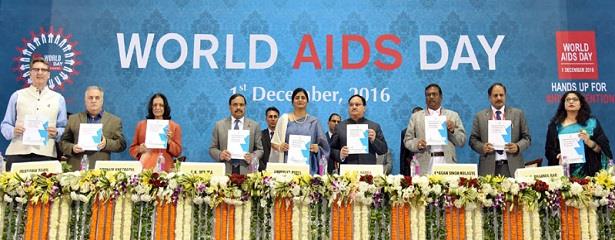
“Our concerted efforts and strategies have been able to see a success story of India. We can now safely say that we can end the HIV/AIDS epidemic by 2030.” This was stated by Shri J P Nadda, Union Minister of Health and Family Welfare at a function on the occasion of World AIDS Day, 2016 organised by the National AIDS Control Organisation (NACO), Ministry of Health and Family Welfare, here today. During the function the Health Minister also released the NACO My Stamp, HIV Counselling and Testing Services Guidelines and a Booklet on Assessment of Blood Banks in India. Shri J P Nadda also launched the NACO Mobile Application having a risk calculator on HIV/AIDS, service directory, addressing myths and misconceptions regarding HIV/AIDS, and a link for a National Toll Free AIDS Helpline and Social Protection scheme.
Shri Faggan Singh Kulaste, Hon’ble MoS (Health & Family Welfare), Smt. Anupriya Patel, Hon’ble MoS (Health & Family Welfare), Dr Poonam Khetrapal Singh, Regional Director of WHO South-East Asia, Shri C.K. Mishra, Secretary (Health & Family Welfare), Dr. Jagdish Prasad, DGHS, Henk Bekedam, WHO Representative to India and Mr. Oussama Tawil UNAIDS Country Director in India also graced the occasion.
Speaking on this occasion, Shri Nadda informed that the Government of India has taken major policy decisions towards strengthening the fight against the epidemic. “It has been decided that the National AIDS Control Programme will continue as a Central Sector Scheme,” Shri Nadda said. He also mentioned that as was announced last year, that the Ministry will start ART and the cut-off level for initiation of Anti Retrieval Therapy (ART) will be raised to a CD4 count of 500. “This has been now implemented and we are working on raising the bar further to TREAT ALL and have started discussions on those lines,” Shri Nadda informed.
“I am happy to announce that we are now treating more than 10 lakh patients with free ARV therapy. I am proud to announce the attainment of milestone of initiation of treatment of the millionth person with free ARV drugs. As promised last year, third line ART is now available free under the ART programme,” Shri Nadda further added.
Shri J P Nadda stated that India was predicted to be the AIDS Capital of world around two decades ago but have now successfully arrested the epidemic of HIV. “There is a consistent decline in HIV prevalence over the years, 57% reduction in the incidences of new infections, and 29% decline also in the number of AIDS-related deaths,” Shri Nadda added.
Shri J P Nadda also cautioned that the emergence of new pockets of infection among IDU, rising trends in some low prevalence states like Orissa, Punjab, Jharkhand etc while states like Manipur, Nagaland, Mizoram, AP, Karnataka, Gujarat, Goa continue to have prevalence higher than national averages. “We not only need to re-strategize as newer vulnerabilities continue to emerge, and there is also the need to expand the scope of our services.” Shri Nadda said.
Addressing the gathering, Shri Faggan Singh Kulaste, MoS (Health & Family Welfare) said that we need to work hard and with full zeal to eliminate the infection by 2030. The task is clearly laid out and we have guidance from all our technical partners here on how to do it. “We need to put our resources and energies in states where we see new infections or more deaths of inadequate responses so that gains made in better performing states do not get diluted in the overall national picture. We have to increase pace of our march towards our commitment during “ending AIDS by 2030” Shri Kulaste said.
Smt Anupriya Patel, MoS (Health & Family Welfare) stated that this day reminds us that we have come a long way from the time when HIV was considered to be something dreadful to days when the disease has been accepted in the society like any other chronic disease for which one has to take lifelong treatment and one can live fairly well with treatment. “This has been possible by joint efforts of dedicated and professional human resource at different levels,” Smt Anupriya Patel added.
Smt Anupriya Patel informed that India has second largest number of PLHIV on ART with nearly 1 million on ART out of 2.1 million estimated with HIV. Nearly 1.4 million have been detected out of 2.1 million estimated with HIV. “We have to ensure that we not only provide drugs, we ensure that the stigma goes away, people can live in dignity, they can get social benefits of Govt of India and do not lose out on economic front and are not discriminated at work place,” Smt Anupriya Patel stated.
Dr Poonam Khetrapal Singh, Regional Director of WHO South-East Asia, stated that the need of the hour is innovation and strike where great impact can be seen. Dr. Khetrapal emphasised on the need for proactive action and sustainable financing to the HIV/AIDS programmes.
Shri. C.K. Mishra, Secretary (Health & Family Welfare) stressed on the need to create new strategies for the new challenges emerging in this sector. Shri Mishra said that we have achieved remarkable success in stopping HIV/ AIDS and the model we adopted in this country is being emulated globally. “This shows how a unified leadership came together. Common thread in the programme is partnership as this task was not possible for a single entity,” Shri Mishra added. He further suggested that now we need to align our approaches with the Rashtriya Kishor Swasthya Karyakram (RKSK), adolescent health programme of the Ministry so that all the adolescents in the country are safe and covered.
Also present on this occasion were students, representatives of NGOs and development partners and other senior officers of the Health Ministry.


